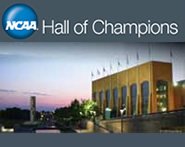NCAA News Archive - 2009
« back to 2009 | Back to NCAA News Archive Index
|
|
By Tim Selgo
The NCAA News When people first hear about our Division II game-environment initiative, I know what the reaction will be: “Great! It’s about time somebody paid attention to sportsmanship!” In fact, every responsible administrator and coach should want better sportsmanship. It’s one of the six basic attributes of Division II membership, and it’s a fundamental principle of intercollegiate competition. But what we’re trying to accomplish in Division II goes beyond sportsmanship. Specifically, Division II is trying to create a climate that will encourage more people to attend our events. Division II athletics is great for participants – more than 90 percent of student-athletes say they would recommend their experience to others – and it’s great for fans. How many other events provide you with close-in parking; inexpensive tickets; and a close-up view of high-quality, college-level athletes (like the track and field, swimming and wrestling student-athletes here this week) competing as hard as they can? It’s all a tremendous value for families who are looking for suitable entertainment. We are foolish indeed if we permit inappropriate behavior, either in competition or in the stands, to ruin our events. And that doesn’t even get into the basic question of behaving properly simply because it’s the right thing to do. So, yes, for many reasons, it’s about time that we paid more attention to sportsmanship. But we also need to pay more attention to something else: entertainment. In my 13 years as athletics director at Grand Valley State, I have seen hundreds of Division II athletics contests, and the problem at far too many has not been bad behavior. It has been disinterest. This isn’t necessarily the fault of the fans. After all, they usually come to events to be entertained and involved. They want to be loud, but it’s uncomfortable to yell alone. Noise may be contagious, but so is silence. Here’s a surprising fact: Student-athletes consistently counsel administrators to act carefully when dealing with sportsmanship. It’s not because student-athletes are bad sports (in fact, they are almost always very good sports). Instead, student-athletes have seen too many cases where well-meaning administrators have restrained behavior to the point that fans are afraid to yell. These athletes make a good point. Surely the answer to dealing with out-of-control behavior involves something other than creating a polite, almost sanitized, event. With that in mind, consider these three tests when you think about the proper Division II game environment: • Is the event conducted in a civil manner? This involves sportsmanship, both in competition and in the stands. • Are fans made as comfortable as they can possibly be? Features like chair-back seats may be hard to implement because of cost, but others – like clean restrooms and healthier choices at concession stands – are virtually free. • Are steps taken to ensure that the event is as entertaining as possible? Bands and cheerleaders are extremely invigorating, but there are hundreds of other ways to spice things up. If you think about it, most Division II institutions can find a great advantage in their smallness. They can achieve personal relationships with their fans that large Division I programs can only dream of. Those relationships have the potential to build exciting events for participants and spectators alike. Let’s take a step in the right direction this week by treating our swimmers, divers, wrestlers, and track and field athletes to some positive – and high-energy – support. Tim Selgo is director of athletics at Grand Valley State and chair of the Division II Management Council. Learn more about the Division II game environment at diicommunity.org.
|
||||||||||||||||||
© 2010 The National Collegiate Athletic Association
Terms and Conditions | Privacy Policy


